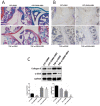Low-Frequency Vibration Promotes Tumor Necrosis Factor-α Production to Increase Cartilage Degeneration in Knee Osteoarthritis
- PMID: 32532183
- PMCID: PMC8804826
- DOI: 10.1177/1947603520931178
Low-Frequency Vibration Promotes Tumor Necrosis Factor-α Production to Increase Cartilage Degeneration in Knee Osteoarthritis
Abstract
Objective: Low-frequency vibration accelerates cartilage degeneration in knee osteoarthritis (KOA) rat model. In this article, we investigated whether whole-body vibration (WBV) increases cartilage degeneration by regulating tumor necrosis factor-α (TNF-α) in KOA.
Design: Proteomics analysis was used to filter candidate protein from synovial fluid (SF) in KOA people after WBV. Enzyme-linked immunosorbent assay (ELISA) was used to estimate changes in TNF-α levels in SF. The C57 mice and TNF-α knock-out mice were sacrificed for the KOA model and WBV intervention. The cartilage was tested by ELISA, histology, terminal-deoxynucleotidyl transferase mediated nick end labeling (TUNEL), immunohistochemistry, and reverse transcriptase polymerase chain reaction. Luciferase activity test in vitro study was conducted to confirm the relationship between TNF-α and the candidate protein.
Results: Differentially expressed proteins were enriched in the glycolytic process, glucose catabolic, and regulation of interleukin-8 (IL-8) secretion processes. Phosphoglycerate kinase, triosephosphate isomerase 1, T cell immunoglobulin- and mucin-domain-containing molecules 2, fumarylacetoacetate hydrolase (FAH), and TNF were the hub node. TNF-α expression increased in SF after WBV (P < 0.05). The cartilage was more degenerated in the TNF-α-/- mice group compared to controls. A significant change was observed in collagen II and FAH (P < 0.05). TNF-α expression improved in C57 mice (P < 0.05). Apoptosis of chondrocytes was inhibited in TNF-α-/- mice by the TUNEL test. Luciferase activity significantly increased in TNF-α + FAH-Luc cells (P < 0.05).
Conclusion: A novel mechanism underlying WBV-triggered cartilage degeneration was found in KOA that demonstrated the critical regulatory function of TNF-α and FAH during WBV.
Keywords: cartilage; degeneration; knee; osteoarthritis; vibration.
Conflict of interest statement
Figures




References
-
- Wang P, Yang X, Yang Y, Yang L, Zhou Y, Liu C, et al.. Effects of whole body vibration on pain, stiffness and physical functions in patients with knee osteoarthritis: a systematic review and meta-analysis. Clin Rehabil. 2015;29(10):939-51. - PubMed
-
- Wang P, Yang L, Liu C, Wei X, Yang X, Zhou Y, et al.. Effects of whole body vibration exercise associated with quadriceps resistance exercise on functioning and quality of life in patients with knee osteoarthritis: a randomized controlled trial. Clin Rehabil. 2016;30(11):1074-87. - PubMed
-
- McCann MR, Patel P, Pest MA, Ratneswaran A, Lalli G, Beaucage KL, et al.. Repeated exposure to high-frequency low-amplitude vibration induces degeneration of murine intervertebral discs and knee joints. Arthritis Rheumatol. 2015;67(8):2164-75. - PubMed
-
- Qin J, Chow SK, Guo A, Wong WN, Leung KS, Cheung WH. Low magnitude high frequency vibration accelerated cartilage degeneration but improved epiphyseal bone formation in anterior cruciate ligament transect induced osteoarthritis rat model. Osteoarthritis Cartilage. 2014;22(7):1061-7. - PubMed
Publication types
MeSH terms
Substances
Associated data
LinkOut - more resources
Full Text Sources
Miscellaneous

